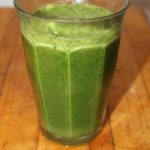Smoothies and honey are a great mix. Why? Because honey is a natural and really great sweetener. It’s on par with maple syrup (most experts will tell you it’s healthier). And it’s so much better than sugar or an artificial sweetener.
And if you’re going to be making a smoothie, then you’re probably not going to want to make it unhealthy by adding sugars, simple syrups, or any of those flavored syrups that you see in stores—even if they are low cal syrups.
Honey is not something I add too often to smoothies, but when I do want to sweeten my smoothies, then I only use honey or maple syrup.
Why Use Raw Honey in a Smoothie?
So, like I mentioned above, I don’t often use honey in smoothies. Why? because I’m a big fan of berries in smoothies. And if you’re adding berries to smoothies, then you are getting a lot of fructose…which will make the smoothie taste pretty good.
However, if you are new to making smoothies, and have started making them with unflavored protein powder (which I suggest using) then you might need to add a sweetener such as honey.
There are a whole lot of reasons why I suggest that you only use a natural unflavored protein (you can read more about it here and here).
Suffice to say, while there are some good flavored protein powders (and I do suggest that if you’re only mixing with water) when it comes to a daily smoothie with protein powder, stick to natural unflavored stuff.
So, the easy solution is honey. It’s a great natural sweetener, and it’s cheap, and it doesn’t spoil. So why use raw honey?
Well, there are a couple of reasons. Let’s take a quick look at them:
- Raw Honey Is Better Than “regular honey” (more on that later)
- Raw Honey Isn’t Super Expensive
- Raw Honey has more varied tastes
Let’s take a look at that last point. Raw honey will have a more subtle and complex flavor. Regular store brought honey is heated and treated to give it a uniform taste.
This heating also happens to destroy much of the health benefits of the honey (as we will discuss in the following section).
Is Raw Honey Better Than Regular Honey?
It’s better if you are considering health factors and flavor complexity. Those two issues alone make it a superior honey.
Let’s look at the health benefits. First, raw honey is not heat processed and super filtered. Honey does not need to be heat processed. It does not go “bad” if not heated. There is no need to pasteurize or otherwise alter it.
All that happens when you heat treat the honey is that you’re turning it into essentially a honey flavored sugar. You are destroying a great deal of the health benefits to the honey.
This is why all people who are into not just health, but the flavor experience of honey will always choose raw honey. So, all things considered, this is why I think raw honey is better for smoothies: flavor and health.
Raw honey has an entire host of health benefits as well that you won’t find with regular honey. The vital nutrients that raw honey has is not something that is found in regular honey. (links to some of the benefits at the bottom of this article).
Can You Add Raw Honey To A Smoothie With Liquid?
Yes, you can certainly add raw honey to a smoothie. I’ve done it myself on occasion when making a smoothie without berries.
Honey blends up excellently. Now, there is a choice to consider: creamed raw honey or regular liquid raw honey.
When you get honey from honey combs, the next step is to spin it and separate it and then strain it. That is liquid honey and it’s then ready to eat. You can just bottle that raw honey and you will have a liquid honey such as these:
If you prefer a more creamy smoothie, then you should consider buying creamed honey. This can also be raw, it’s just that the honey has been creamed. This is a process where the honey is whipped to incorporate air so that it becomes more stable. It’s like a softish peanut butter.
I happen to like creamed honey and think it’s perfect if you want a smoothie texture but don’t want to add something like a peanut butter or avocado. I cover creamed honey in more detail in this blog post on the best honeys to use in a smoothie.
What To Mix With Raw Honey in a Smoothie?
You can add honey to any type of smoothie. I like to add it as a sweetener, but realize that honey itself is good ingredient that is not just for flavor.
Honey and unflavored protein is a great match. If you’re using something like an organic unflavored whey protein or vegetable protein, then honey is perfect.
Honey is also good for green smoothies. If you’re making a kale or wheatgrass smoothie, then it’s good to add a flavor component that improves the flavor. I like adding a lemon, but a lemon and honey mixture would also be great.
I would always opt to use raw honey in a smoothie if I wasn’t adding a ton of fruit. So, for instance, I would like to suggest adding honey with:
Unflavored Protein Powder and Honey
This is one of the best ways to use honey. If you’re using a natural, organic, and unflavored protein powder, then honey is a great way to make it sweet.
(what i’d note is that even in a flavored proteins such as vanilla goes well with honey. I’m not a big fan of chocolate and honey).
Green Smoothies with Lemon
If you’re making a green smoothie, then you can certainly add honey. I would suggest that you only use honey if you’re also using something such as lemon which will cut the sweetness. The lemon and the honey will be a good compliment to each other.
Turmeric Smoothie and Lemon with Honey
The other idea that I’d like to comment on is turmeric and lemon and honey. Turmeric is super healthy and it has a strong earthy flavor. The lemon cuts that earthy flavor, and if you’d like to get that tartness dialed down a bit, then what you could do is add some natural raw honey.
Smoothies with Oats and Honey
Honey and oats are a great mix. And that’s why it’s one of the number one matches for smoothies. It’s a perfect combo. If you’re looking for a post-workout smoothie then add in some protein powder and a banana. And a lot of people like to toss in some cinnamamon.
Links to Clinical Research
Related Posts

Hi Everyone!
Jenny O’Brien here. Nutritionist & personal trainer. Just your average vegetarian and smoothie fanatic!
If you have any questions, or you’d like me to cover a particular topic, drop me a line and let me know!
Thanks!






